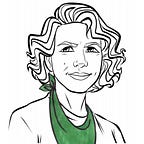Bringing Open GLAM to the world, and the world to Open GLAM
A year ago, Douglas McCarthy and I founded this publication with the aim of bringing together existing conversations about Open GLAM, and to welcome new voices to join. As many professionals and practitioners were already using this platform, it was easy to get started on Medium without investing a lot of time and resources. So we decided to try it out and gauge interest from readers and writers alike.
A year later, the publication features over 50 articles in at least six different languages. Highlights include a great series by Anne Young on how to do Open GLAM and an introduction to Andrea Wallace and Douglas’s Open GLAM survey, available in English, Italian and Spanish. All told, it’s a broad collection of articles by Open GLAM advocates making the case for responsible open access to cultural heritage.
Medium has also been a good way to continue conversations happening on the Open GLAM Twitter account. Some of these Twitter interventions have been converted into posts; other conversations have been published as interviews and transcripts. Our goal throughout has been to elicit, host and share conversations on Open GLAM.
Who’s missing in the conversation?
A crucial part of this work is regularly asking ourselves, “Who’s missing in this conversation? Why? What can we do about it?”.
I was recently reviewing some of the great pieces that our authors have shared with us on why and how they pursue Open GLAM. Reading Karin Glasemann’s ‘Inside the museum is outside the museum’ inspired me to recall similar examples from Latin America — that one rarely has the chance to read about. Whilst we know that North American and European institutions dominate the Open GLAM scene, it’s hard to expand open access globally if leading professionals and advocates in other parts of the world can’t easily share their stories.
Can we help fix this?
“We need more case studies” is something we hear all the time. Ever since the Brooklyn Museum opened up its collection back in 2004, evidence-based studies have been growing in number. Some people have been amazingly vocal about the benefits (and challenges) of Open GLAM, presenting their arguments in compelling ways.
Sometimes, however, this is still not enough. In some contexts and countries, people are less able to relate to these case studies. If “one size fits all” examples are rare, this is particularly true for institutions, professionals and advocates working in challenging contexts. For these people to be able to come forward, sometimes they need to buy themselves the time to talk about what they do.
To encourage these stories to emerge, this year we are financially supporting the production of 16 stories on Open GLAM in the Global South or in underrepresented communities.
What’s coming next
We are currently still receiving applications. With the help of an amazing selection committee composed of Douglas, Mariana Ziku from the Biennale of Western Balkans, and Franziska Latell, we have already selected some stories that’ll be going live soon.
Virginia Inés Simón, from Argentina, will share some of the challenges that GLAM institutions face when adapting documents for people with disabilities, and how accessibility might be the new frontier for an ethical Open GLAM.
Biyanto Rebin will be talking about the state of Open GLAM in Indonesia and how digital cultural heritage there is being shared online.
Daniela Schütte and Samuel Salgado Tello from Chile will attempt to classify open access practices and their implementation in Chile. They’ll examine how they permeate institutional policies, and showcase case studies from Chilean GLAMs that have, in one way or another, tried to make collections accessible through platforms and digitization projects.
Also from Latin America, João Peschanski will share his experience of partnering with the Museu Paulista da Universidade de São Paulo (Brazil) to bring their digital collection to Wikimedia Commons. He’ll describe how the 25,000 items shared so far have catalysed a bold partnership that includes open innovation, education, dissemination and accessibility.
Finally, Isaac Oloruntimilehin will present a historical review of GLAM institutions in Nigeria that conclude with ways forward for GLAM institutions to adapt and release creative works under open licenses and in the public domain.
Want to apply? Don’t delay!
The call is still open if you want to submit a proposal for a story. We’re evaluating stories on a “first come, first served” basis and we’ll be reaching our limit of stories soon! Don’t overthink it: just send us a title, a short summary of what you want to write, and make sure that your project or case study complies with the Open Definition.
We want to thank Creative Commons for its generous support for the CC Open GLAM Platform; the CC Open GLAM Platform community that reviewed our plans for this year; and the selection committee made up of Douglas McCarthy, co-editor of this publication, Mariana Ziku and Franziska Latell.
